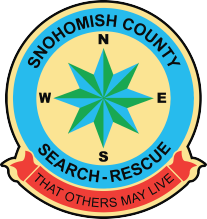Return to the blog
Helicopter Rescue Team (HRT) – Recent Rescue & Team Capabilities
November 22, 2022
Taylor Isabell, SCVSAR, Snohomish SAR Unit Member
On a sunny Monday afternoon in August, Ryan Mueller and his party began to work their way tentatively across a snow and ice field at 5900 feet of elevation on Three Fingers Mountain. It was day two of what was supposed to be a three-day backpacking trip that, so far, had gone almost perfectly. The day before, some light rain had blown through, clearing the mountain air of lingering wildfire smoke, making for breathtaking views of the surrounding peaks. Ryan, leading the group, moved into an exposed area of the snow and ice field and assessed the conditions. A seasoned hiker, backpacker, and climber, having logged some thirty years of experience in the mountains, he made the call that the snow was too slick and the remainder of his party too inexperienced to attempt the summit of Three Fingers that day. As he turned to relay the news to the group, standing over 2000 feet above the valley below, his left foot slid out from under him. The slip sent Ryan tumbling and sliding downhill where, a hundred feet below where he started, he slammed feet-first into exposed rocks, stopping his fall.
After taking a few moments to collect himself, he realized his right ankle was certainly broken, and that it would be impossible for him to climb back up the way he came. Fortunately, Ryan wasn’t more seriously injured. He was carrying an InReach, and activated its SOS function.
At 2:13 that afternoon, SCVSAR’s Helicopter Rescue Team (HRT) was notified of the mission and paged their volunteer crew members to respond. Two crew chiefs and a flight paramedic responded, and with two Snohomish County Sheriff’s Office pilots at the controls, “SnoHawk10” lifted off and headed for Three Fingers.
Arriving at 3:40 PM, the crew quickly located Ryan on the rock face, lowering the Flight Medic to his position 160 feet below the hovering UH-1H “Huey.” After helping him in to a “screamer suit”, a device that allows rescuers to hoist subjects to the helicopter in a seated position, Ryan was hoisted the 160 feet back up to the aircraft and flown to the emergency department at Providence Hospital in Everett. But first, the HRT delivered the rigging gear Ryan was carrying to his party on the ridge line. Since the accident, Ryan has undergone surgery to repair three broken bones in his foot and two ankle fractures. “All things considered, I’m doing pretty well,” he said. Ryan caught up with the HRT crew in Taylor’s Landing later in the summer, saying, “It was amazing to meet everyone who was part of rescuing me that day and seeing your facility in person. I’m really thankful for the volunteers who were there that day.”
SCVSAR’s Helicopter Rescue Team is an “all hazard” response team that conducts more than 80 missions per year throughout the Pacific Northwest. Though the majority of the missions are within Snohomish County, the team also provides assistance for out-of-county emergencies. Calls include missing children, lost Alzheimer’s patients, overdue hikers and rafters, persons trapped by flood waters, and injured climbers and skiers. The terrain varies widely from urban areas to the most remote sections of the rugged Cascade Mountains. The Bell UH-1H “SnoHawk10” is used primarily as the rescue helicopter. It is equipped with a Rescue Hoist, which is the best tool for inserting rescuers and extracting injured subjects.
HRT responds to emergency situations when the nature of the injury or terrain requires extraction by air. They bring life-saving equipment, rescue personnel and paramedics directly to patients to help reduce disability and to improve their chances for survival. HRT resources include pilots, crew chiefs, helicopter rescue technicians, flight medics/paramedics and ground support personnel. Although some of the pilot positions are filled by Sheriff Deputies, the vast majority of the positions are filled by volunteers. They are incredibly dedicated to their job and upholding the motto “so that others may live”.
For the most current SAR information, please “like” our “Snohomish County Volunteer Search & Rescue” Facebook page and our “snohomish_county_sar” Instagram page. You can also find stories at www.scvsar.org/blog.


 Donate
Donate


